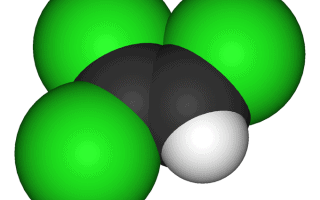
3D representation of a trichloroethylene molecule.
Trichloroethylene is a colorless liquid that is used in many industries as a degreasing agent. It’s one of those chemicals that we really don’t think much about exposure to, but that can have very harmful health effects when exposure does occur. In this article, we’ll take a quick look at what trichloroethylene is, how it affects the human body, and what you can do to limit your chances of exposure to it.
First, a Bit About Trichloroethylene
Sometimes abbreviated TCE for brevity, trichloroethylene is an organic halocarbon molecule consisting of 3 chlorine atoms and one hydrogen atom bonded to two double bonded carbon atoms. It has, for many years, been used to degrease metal parts in factories and fabrication shops. It has also been used for the extraction of vegetable oil, and in gaseous form was once widely used as an anesthetic. Now, its main use is in industry, as research has shown that the liquid has many negative impacts on human health, making it impractical in food processing and as an anesthetic.
Exposure to TCE is most common in a workplace environment. However, it is present at lower levels in many places. In some places near older industrial sites, TCE has seeped into groundwater, contaminating both soil layers and aquifers. It is also found, in low concentrations, in various household cleaners and lubricants.
Health Effects of TCE
Trichloroethylene has a long list of potentially hazardous health effects. As one might expect given its long term use as an anesthetic, one of the more prominent symptoms of TCE exposure is nervous system depression, eventually leading to a state of anesthesia. It has also been found to be carcinogenic when low level exposure continues long term. TCE can also contribute to the onset of autoimmune diseases, and research has shown that long term exposure to trichloroethylene can increase the risk of Parkinson’s disease by as much as six times the normal risk level.
Limiting TCE Exposure
Given all of this information, it’s pretty clear that TCE exposure should be avoided as much as is humanly possible. To reduce exposure to TCE in the air, one of the very best options is to use a high end air purifier that is capable of removing gases, instead of just particulates, from the air. Fortunately, there are specialized air purifiers that are intended to do just this.
In the residential range, which will help you to vastly reduce the risk of exposure in your home, US Air Purifiers offers the Airpura C600, one of the best residential air purifiers on the market. With an effective coverage space of 2000 square feet, the C600 is ideal for almost any home. Aside from just TCE, the C600 removes many other airborne toxins, such as ammonia compounds, gasoline, mold toxins, and toluene. For more information and a complete specifications listing on the C600, click here.
If you have an industrial facility in need of complete air cleaning, however, a residential air purifier simply will not be sufficient. For industrial needs, as well as for marijuana dispensaries, police evidence rooms, and other such environments, we recommend our new Amaircare Vocarb units. The 6000V and 7500 units are cart-mounted industrial air purifiers capable of covering 36,000 and 60,000 square feet, respectively. Each one is capable of removing both gases and particulates from the air, and will effectively purify almost any industrial space. For more information on the 600oV model, click here, and for the 7500, click here.
Conclusion
While trichloroethylene can be quite dangerous, it is also not impossible to take adequate precautions against. The use of a good air purifier in the home or workplace can greatly reduce the risk of TCE exposure, as well as exposure to other harmful gases. For more information about the health effects of TCE, you can check out a page dedicated to it by the Minnesota Department of Health here.
Want to learn more about improving the quality of the air you breathe? Like us on Facebook for weekly blog updates.